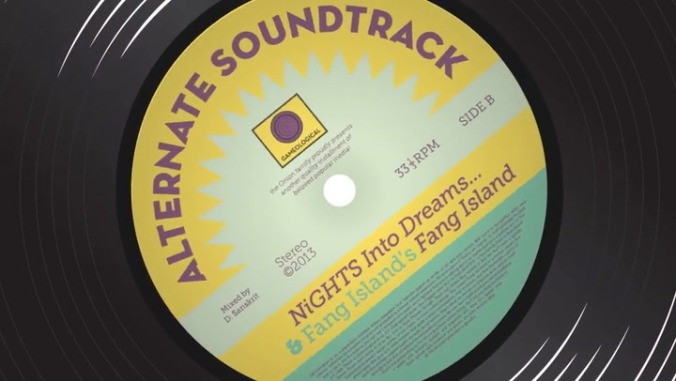We combine NiGHTS Into Dreams… and Fang Island with rapturous results
Video game music can be great, but sometimes it’s fun to pair your wine with some different cheese. In Alternate Soundtrack, Derrick Sanskrit matches a video game with an album that enhances the experience.
The Game: NiGHTS Into Dreams… (1996)
The Album: Fang Island, Fang Island (2010)
Often it’s not a work’s story that we cling to but the feelings it evokes. Doctor Who instills a sense of wonder and delight. Dave Eggers’ Zeitoun inspires outrage and incredulity. Richard Curtis’s Love Actually coaxes out warm feelings of love, actually. And then there are games like NiGHTS Into Dreams… and albums like Fang Island’s self-titled LP that don’t have any particular story to tell in the first place. They just want to make the audience feel joyous and free. Their entire purpose is goodness and light, sharing the positive vibes and harshing nobody’s mellow.
Originally released on the Sega Saturn in 1996 (and available on the Xbox 360 and PlayStation 3), NiGHTS Into Dreams… was the first game from Sega’s Sonic Team that didn’t star Sonic The Hedgehog. You control an androgynous dream jester named NiGHTS who vanquishes nightmares by flying through them and infusing them with a trail of sparkles. One of the last mascots of the era before video games became dominated by stubble-flecked space marines, NiGHTS represents wholesome whimsy; the character remains a counterpoint to the encroaching darkness in turn-of-the-millennium media.
Fang Island, meanwhile, is a rock ’n’ roll band reminiscent of Wyld Stallyns from the Bill & Ted films, sharing the belief that world peace and togetherness can be brought about via sweet guitar licks. Fang Island has described its sound as “everyone high-fiving everyone,” a claim that’s hard to dispute considering the victorious atmosphere of its harmonious chords and huge, chorus-like chants. A band of art school graduates, Fang Island introduced itself to the world with colored smoke bombs and glitter paint, combating the “Why so serious?” 2010s with garage rock anthems of exultation.
Much like the dream jester of NiGHTS, the music of Fang Island soars. The dual guitar harmonies in “Sideswiper” simulate elevation and a higher plane of being. One voice is the silver-lined clouds, wafting gently overhead with unknown promise. The other voice is its shadow, just as delicate and complex but grounded in earthly familiarity. Neither is entirely tangible, but the two act together to give a sense of scale, distance, and grandeur.
Like so much glitter, a twinkling crystal arpeggio highlights the airier moments in “Daisy” and “Life Coach,” lifting hearts with synthesized faerie dust. This is what it sounds like when Peter Pan asks children to think happy thoughts, just before pushing them out the window with a fierce shred of garage-rock grit. The slow and steady build of “Davey Crockett” is like a lucid dream, growing in intensity for no reason other than the dreamer willing it. The massive swirls of rock ’n’ roll compound until reality slips away entirely, and we are left floating on a cushion of guitar fuzz and good cheer.
Fang Island, the album, is bookended by the sounds of fireworks. Fuses are lit, sparks crackle, and rockets burst into the sky. All we have is the audio, just enough reality to allow us to fantasize the visual. Perhaps the unseen fireworks resemble the starburst left in the wake of NiGHTS’ acrobatic loop-de-loops, or maybe they’re more like the exploding, dream-retaining piggy banks that the jester barrels through in each stage of the game, bursting with colorful energy and light. The album provides some pieces, but the patterns and colors of the explosions are up to our imaginations, much like the era of video game imagery that NiGHTS Into Dreams… represents. Faced with graphics technology that couldn’t create a convincing simulation of reality, the Sonic Team didn’t bother with realism. They threw themselves into the fantastic and the evocative instead.
